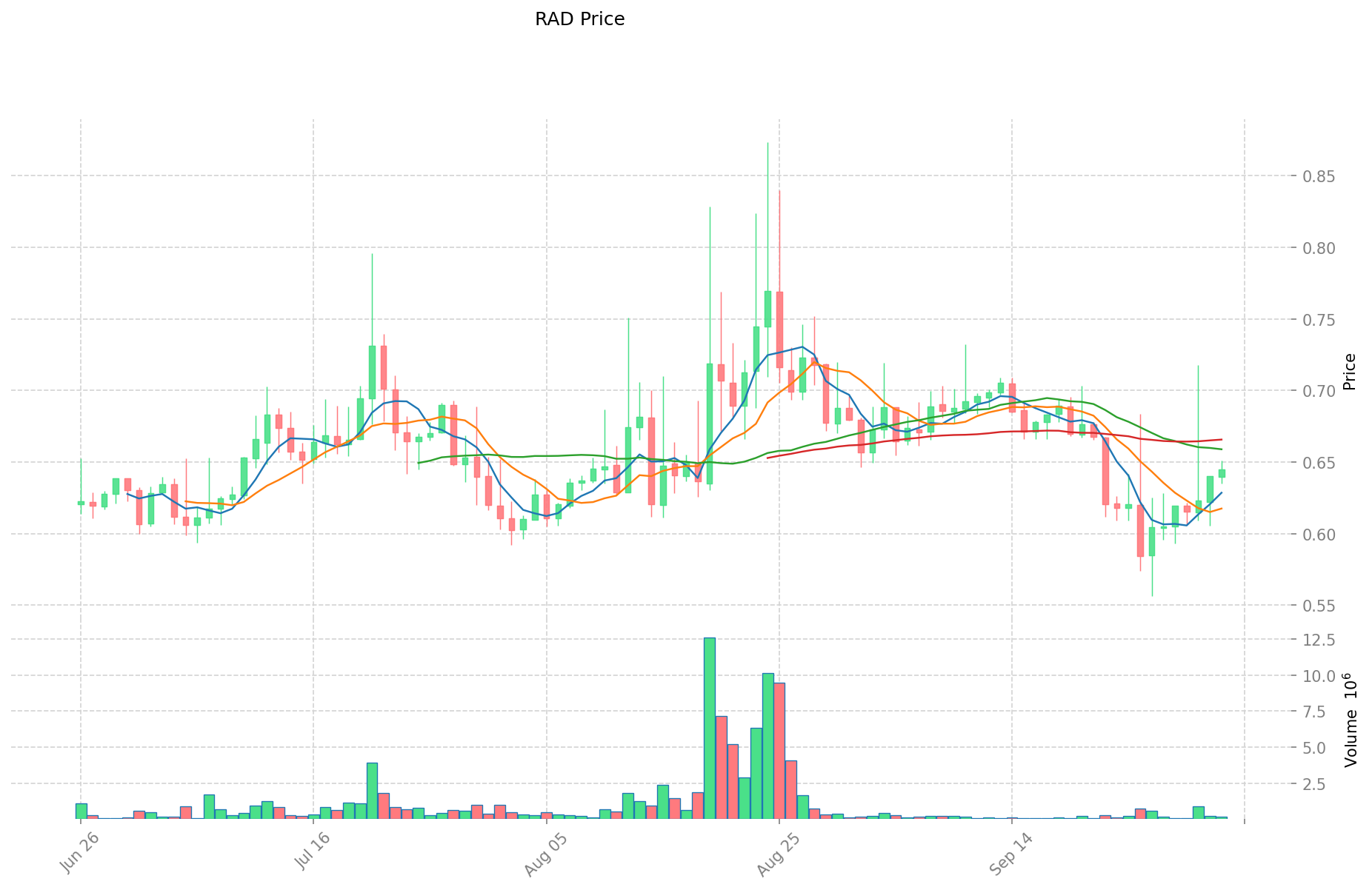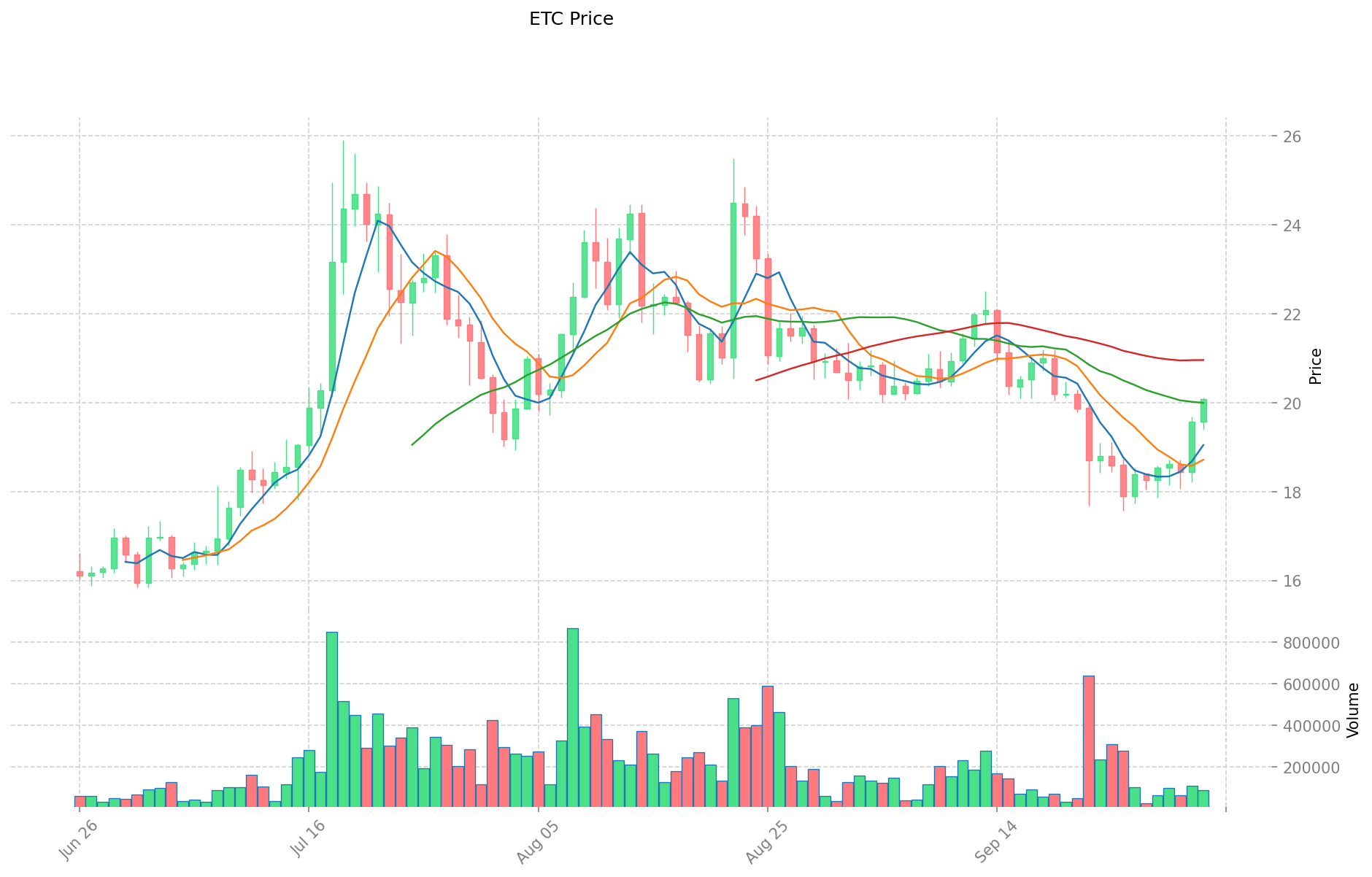RAD vs ETC: A Comparative Analysis of Two Trading Mechanisms in Modern Financial Markets
Introduction: RAD vs ETC Investment Comparison
In the cryptocurrency market, RAD vs ETC comparison has always been a topic that investors can't avoid. The two not only have significant differences in market cap ranking, application scenarios, and price performance, but also represent different cryptocurrency asset positioning.
Radicle (RAD): Since its launch in 2021, it has gained market recognition for its Web3 native network for software collaboration.
Ethereum Classic (ETC): Since its inception in 2016, it has been hailed as a continuation of the original Ethereum chain, adhering to the "code is law" principle.
This article will comprehensively analyze the investment value comparison between RAD and ETC, focusing on historical price trends, supply mechanisms, institutional adoption, technological ecosystems, and future predictions, attempting to answer the question that investors are most concerned about:
"Which is the better buy right now?" Here is the report based on the provided template and information:
I. Price History Comparison and Current Market Status
RAD and ETC Historical Price Trends
- 2021: RAD reached its all-time high of $27.61 due to increased interest in decentralized development platforms.
- 2016: ETC was created as a result of the Ethereum hard fork, with its price initially volatile.
- Comparative analysis: During the 2021-2022 crypto market cycle, RAD dropped from its peak of $27.61 to a low of $0.565759, while ETC showed more resilience, maintaining a higher market cap.
Current Market Situation (2025-10-03)
- RAD current price: $0.6405
- ETC current price: $19.602
- 24-hour trading volume: RAD $70,441.80 vs ETC $1,333,381.73
- Market Sentiment Index (Fear & Greed Index): 64 (Greed)
Click to view real-time prices:
- Check RAD current price Market Price
- Check ETC current price Market Price


II. Key Factors Affecting RAD vs ETC Investment Value
Supply Mechanisms Comparison (Tokenomics)
- Market volatility: When markets decline significantly, collateral values decrease, leading to insufficient subsequent transactions
- Investment efficiency: External environment uncertainties make it difficult for entities to accurately grasp market movement patterns
- Price convergence: Factors limiting investor arbitrage transactions prevent asset prices from returning to reasonable values
Institutional Adoption and Market Applications
- Investor diversity: Markets have numerous investors with varying investment periods, capital costs, and opportunity costs
- Risk factors: Strategic risks, market risks, operational risks, financial risks, and compliance risks all affect investment outcomes
- Value recognition: Maintaining the interests of smaller stakeholders is important in asset restructuring scenarios
Technical Development and Ecosystem Building
- Digital innovation: The greatest innovation in financial inclusion lies in digitalization, which is also a core advantage
- Technology adoption: Expanded use of technologies to minimize production time drives market growth
- Application prospects: Responsive materials show great potential in sensing, intelligent information storage, and anti-counterfeiting fields
Macroeconomic and Market Cycles
- Profit capability: As uncertainties increase, production and operational strategy formulation becomes more difficult, affecting profitability
- Market trends: Different investors need to understand related product values and market trends
- Growth projections: Market values can show significant growth potential over extended periods (as seen in comparable technology sectors)
III. 2025-2030 Price Prediction: RAD vs ETC
Short-term Prediction (2025)
- RAD: Conservative $0.37-$0.64 | Optimistic $0.64-$0.77
- ETC: Conservative $13.12-$19.59 | Optimistic $19.59-$29.18
Mid-term Prediction (2027)
- RAD may enter a growth phase, with prices expected in the range of $0.74-$1.22
- ETC may enter a consolidation phase, with prices expected in the range of $18.61-$33.03
- Key drivers: Institutional capital inflow, ETF, ecosystem development
Long-term Prediction (2030)
- RAD: Base scenario $1.49-$1.72 | Optimistic scenario $1.72-$2.03
- ETC: Base scenario $34.02-$37.53 | Optimistic scenario $37.53-$44.23
Disclaimer
RAD:
| 年份 | 预测最高价 | 预测平均价格 | 预测最低价 | 涨跌幅 |
|---|---|---|---|---|
| 2025 | 0.774521 | 0.6401 | 0.371258 | 0 |
| 2026 | 1.04681954 | 0.7073105 | 0.67901808 | 10 |
| 2027 | 1.2191203778 | 0.87706502 | 0.7367346168 | 36 |
| 2028 | 1.46732977846 | 1.0480926989 | 0.534527276439 | 63 |
| 2029 | 1.7230643969916 | 1.25771123868 | 0.6414327317268 | 96 |
| 2030 | 2.026927432256688 | 1.4903878178358 | 1.222118010625356 | 132 |
ETC:
| 年份 | 预测最高价 | 预测平均价格 | 预测最低价 | 涨跌幅 |
|---|---|---|---|---|
| 2025 | 29.18463 | 19.587 | 13.12329 | 0 |
| 2026 | 28.04368725 | 24.385815 | 23.65424055 | 24 |
| 2027 | 33.0305864175 | 26.214751125 | 18.61247329875 | 33 |
| 2028 | 31.400028897525 | 29.62266877125 | 17.77360126275 | 51 |
| 2029 | 37.528959066296625 | 30.5113488343875 | 29.596008369355875 | 55 |
| 2030 | 44.226200135444681 | 34.020153950342062 | 20.752293909708658 | 73 |
IV. Investment Strategy Comparison: RAD vs ETC
Long-term vs Short-term Investment Strategies
- RAD: Suitable for investors focused on Web3 development platforms and decentralized collaboration potential
- ETC: Suitable for investors seeking a more established blockchain with "code is law" principles
Risk Management and Asset Allocation
- Conservative investors: RAD: 20% vs ETC: 80%
- Aggressive investors: RAD: 60% vs ETC: 40%
- Hedging tools: Stablecoin allocation, options, cross-currency portfolios
V. Potential Risk Comparison
Market Risk
- RAD: Higher volatility due to smaller market cap and newer project status
- ETC: Susceptible to overall crypto market trends and Ethereum ecosystem developments
Technical Risk
- RAD: Scalability, network stability
- ETC: Hash rate concentration, potential security vulnerabilities
Regulatory Risk
- Global regulatory policies may have differing impacts on both assets
VI. Conclusion: Which Is the Better Buy?
📌 Investment Value Summary:
- RAD advantages: Web3 native network for software collaboration, potential for growth in decentralized development
- ETC advantages: Established history, larger market cap, adherence to original Ethereum principles
✅ Investment Advice:
- New investors: Consider a small allocation to RAD for exposure to Web3 development platforms, with a larger portion in ETC for stability
- Experienced investors: Balanced portfolio with both assets, adjusting based on risk tolerance and market conditions
- Institutional investors: Evaluate both assets for their unique positioning in the crypto ecosystem, potentially including both in a diversified portfolio
⚠️ Risk Warning: The cryptocurrency market is highly volatile. This article does not constitute investment advice. None
VII. FAQ
Q1: What are the main differences between RAD and ETC? A: RAD is a newer project focused on Web3 native networks for software collaboration, while ETC is an established blockchain that continues the original Ethereum chain, adhering to the "code is law" principle.
Q2: Which cryptocurrency has shown better price performance historically? A: ETC has shown more resilience in price performance, maintaining a higher market cap during market cycles. RAD, being newer, experienced significant volatility since its 2021 launch.
Q3: How do the current market situations of RAD and ETC compare? A: As of 2025-10-03, RAD's price is $0.6405 with a 24-hour trading volume of $70,441.80, while ETC's price is $19.602 with a 24-hour trading volume of $1,333,381.73.
Q4: What are the long-term price predictions for RAD and ETC by 2030? A: For RAD, the base scenario predicts $1.49-$1.72, with an optimistic scenario of $1.72-$2.03. For ETC, the base scenario predicts $34.02-$37.53, with an optimistic scenario of $37.53-$44.23.
Q5: How should investors allocate their portfolio between RAD and ETC? A: Conservative investors might consider 20% RAD and 80% ETC, while aggressive investors might opt for 60% RAD and 40% ETC. The allocation should be based on individual risk tolerance and market conditions.
Q6: What are the main risks associated with investing in RAD and ETC? A: Both face market risks tied to overall crypto trends. RAD has higher volatility due to its smaller market cap, while ETC faces potential security vulnerabilities. Both are subject to regulatory risks depending on global policies.
Q7: Which cryptocurrency is better suited for long-term investment? A: This depends on individual investment goals. RAD may be suitable for those focused on Web3 development platforms, while ETC might appeal to investors seeking a more established blockchain with "code is law" principles.
Share
Content